Mobile Roundup: A Trio of Midrange Laptops
by Jarred Walton on September 17, 2008 3:00 AM EST- Posted in
- Laptops
Battery Life, Power, and Noise
Gaming and application performance is all well and good, but for most users looking at midrange notebooks battery life is going to be a far more important consideration. Let's see how these laptops fare in comparison to the other notebooks we've tested, although most of the notebooks we tested previously are gaming models so battery life should be quite a bit better.
Battery Life
For battery life testing, we run all laptops at around 100 nits brightness. If you choose to run your LCD at maximum brightness, you may lose anywhere from 10 to 60 minutes depending on the laptop - the latter is mostly for ultra-mobile options while the former is for gaming notebooks. We run four different battery life scenarios: Internet surfing (load several webpages using the wireless adapter every minute until the battery dies), DVD playback, x264 playback, and idle (maximum) battery life. For x264 playback, we copy a 720p file to the hard drive and loop playback using Windows Media Player Classic. We will also include battery life results for Blu-ray playback in the DVD chart.
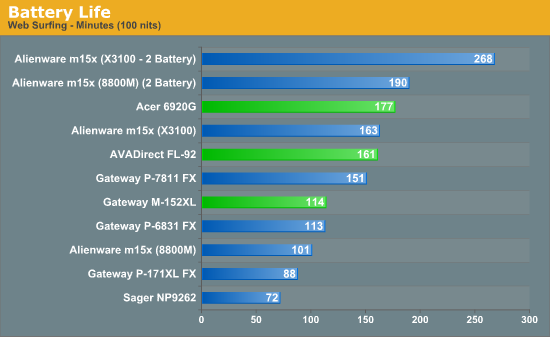
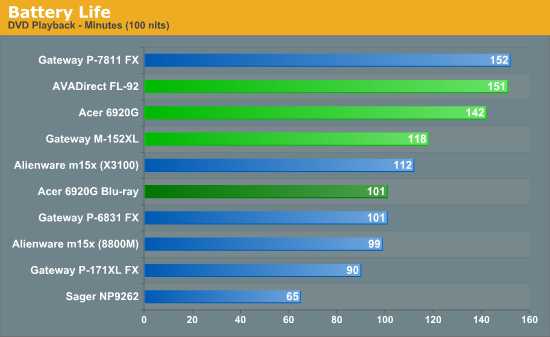

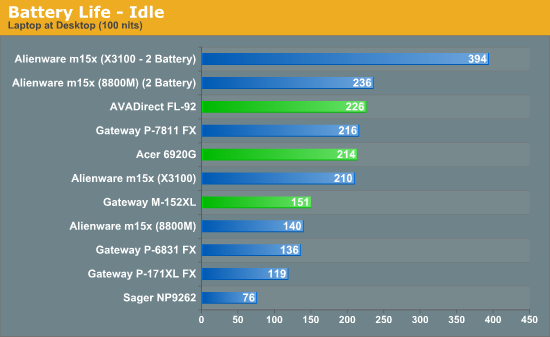
Considering the different battery sizes, it's not too surprising to see the midrange notebooks surpassing most of the other laptops. The AVADirect ends up providing the best battery life of these three options, but its battery is 12% larger than the Acer battery so the Acer actually ends up being the most power efficient. The M-152XL does rather poorly, but if you get the larger battery option (86 Whr) it would move ahead of the other laptops. Playing a Blu-ray movie uses a lot more power than watching a DVD (or x264 movie), unfortunately, so the Acer is only good for just over an hour and a half in that test. (Yup, that's another strike against spending the money on a Blu-ray drive.)
One item that is definitely impressive is that the Gateway P-7811 isn't far behind these notebooks in terms of battery life, showing the benefits of the new lower power processors and DDR3 memory. We are definitely anxious to see more DDR3 equipped notebooks, particularly if we can get some with LED backlighting. Using such a combination, it should be possible to create a midrange notebook that can still get upwards of four hours of battery life during moderate use. Also, while it might be tempting to equate the Alienware m15x with IGP solutions (when the discrete GPU is disabled), it's important to remember that the m15x also has the fastest - and therefore most power-hungry - mobile CPU currently available. We would expect integrated solutions to provide significantly better battery life, all other things being equal.
Power Requirements
Power requirements when a laptop is plugged in don't necessarily reflect power requirements when a laptop is on battery power. In particular, high-end GPUs run at lower maximum clock speeds when using the battery power. That may also occur with the midrange GPUs, but it's not strictly required - the Sager NP9262 battery is simply unable to provide enough power to maintain higher clock speeds. Keep this in mind when looking at the following numbers. We test under idle conditions, with a 100% load placed on the CPU via Folding@Home SMP, and finally at maximum load by running FAH SMP at the same time as we loop 3DMark06 (at 1280x800).

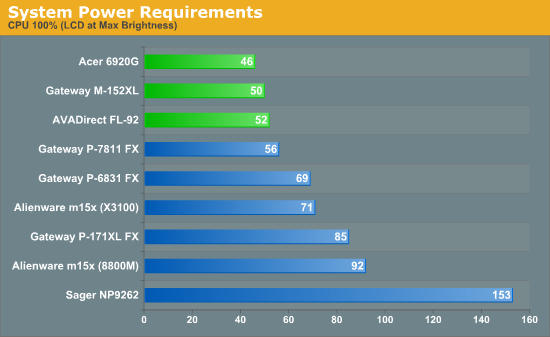
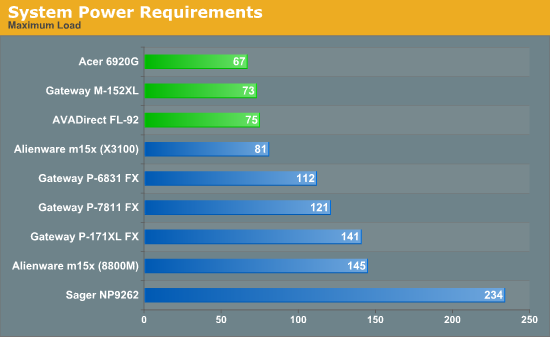
It's tough to draw any firm conclusions without additional details on what sort of clock speeds are used, but the Acer 6920G does place ahead of the other laptops. Since it has a 5400 RPM hard drive, that will account for some of the difference (i.e. the 1W at idle). Display size is virtually equal (the 6920G has an area of 109 in2 compared to 106.5 in2 for the 15.4" LCDs), so that's not a factor, but compared to the AVADirect it's a little odd to see the 6-8W discrepancy under load, especially with twice as much RAM in the Acer. It's probably just minor differences in the motherboard and power brick, plus margin of error for these particular tests (i.e. non-idle power at the outlet) is higher than we'd like. Average power use would be a better measurement, but our Kill-A-Watt device doesn't provide a good way of collecting that data. In other words, pay more attention to the battery life charts.
Noise Levels
We also ran noise testing using an SPL meter at 24" under the same conditions as our power tests.
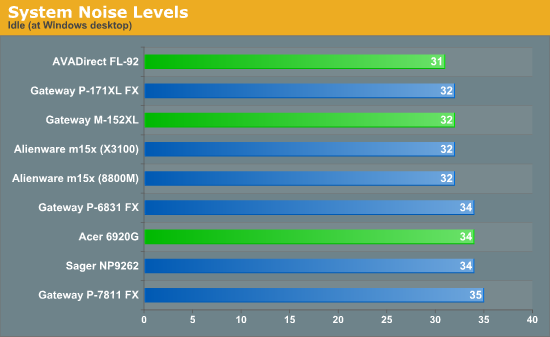
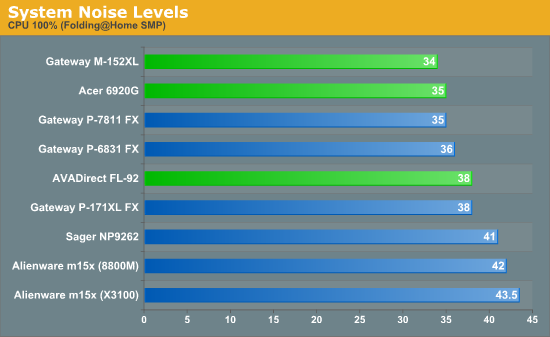

It's a bit of a surprise to see the Acer making more noise under idle conditions by several decibels, but it doesn't get much louder with a heavy CPU load. Putting a load on the GPUs creates the most noise, although the AVADirect gets almost as loud just by stressing the CPU. The M-152XL ends up as the quietest of the three, possibly helped a bit by the slightly slower CPU. The limit of our SPL meter is right around 30dB, so at idle the AVADirect is almost silent. What's not a surprise is that gaming notebooks are typically quite a bit noisier than midrange notebooks, making the midrange options a better fit for office use.










26 Comments
View All Comments
JarredWalton - Wednesday, September 17, 2008 - link
The same way as in http://www.anandtech.com/mobile/showdoc.aspx?i=339...">previous articles, which is to say we ran the built-in test. It may not represent actual gameplay 100%, but that's not really possible with any benchmark of any game, since specific scenes/levels are always slower for faster. The idea is to show the relative performance of the laptops. If memory serves, the built-in performance test usually provided higher numbers than regular gameplay by 10-20%.bob4432 - Wednesday, September 17, 2008 - link
did you have to unlock anything? the reason i ask is because when i run the benchmark test i get 63fps avg from an x1800xt to a 4850 to a 8800gtx to a 9800gtx @ 1280x1024 - 1680x105....rigs have 2-3GB of ram and are running from x2 4200s to e2160@3Ghz to a quad rigJarredWalton - Wednesday, September 17, 2008 - link
You need to add the -novsync option to the command line argument.bob4432 - Wednesday, September 17, 2008 - link
command line?JarredWalton - Wednesday, September 17, 2008 - link
You'll need to manually create a shortcut to the game executable (RelicCOH.exe). Then right-click on the shortcut and choose properties. In the Shortcut tab, under target, add -novsync at the end of the line (after any quotes or other stuff). The 1.70 patch enabled VSYNC by default to provide a higher quality rendering experience, and the Readme file details the above command-line parameter.bob4432 - Thursday, September 18, 2008 - link
thanks for the info - ended up w/ 106fps avg w/ a decent o/c'd 4850, e2160@3GHz and 3GB ddr2-667, so i am happy w/ that. pretty impressed w/ that 7811fx machine. thinking of myself moving up to a 24" 1920x1200 lcd here in a couple days and figure that my next rig will be crossfire since i will probably need it but not too shabby for the price i paid for this current gpu. only thing is the damn heat output :)again, thanks